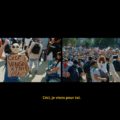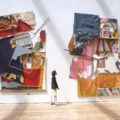“Hybrid of a Chrysler. A Provocation to Fly”. A conversation with Gabriela Azcuy and Esterio Segura
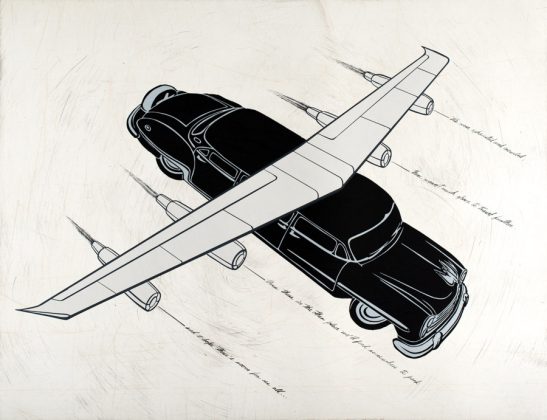
There is no doubt that TRAVEL -in capital letters- embodies one of the great themes of Cuba’s recent history, from a cultural and social point of view. In the idiosyncrasy of Cubans, at least Cubans born since the 1960s, the possibility of migrating has been for decades an ideological constant that for some represents the realization of a dream and a life project, and for others, the frustration caused by the permanence, by the invisible passage of time in a country from which they cannot leave and which is the opposite of development.
Esterio Segura (Santiago de Cuba, 1970) is one of the Cuban visual artists who has most addressed the idea of travel through his work. Segura’s artistic work occupies a whole morphology of displacement through which the artist becomes a kind of inventor who creates in his workshop the devices and artifacts for the journey, whether aerial or marine. For him, “taking flight”, as a metaphor for migration and human exodus, constitutes a sort of obsession that has led him to return to this idea using different formats, again and again, over the years.
Hybrid of a Chrysler, a 1950s Chrysler limousine with two airplane wings grafted onto it, is perhaps, within his varied visual repertoire, the sculpture that best describes what travel represents for him. The apparatus of the artifact and its physical incongruity make Hybrid of a Chrysler a piece in which the expedition could never be realized; it points more to the complexity of the concretion of the journey than to the fact of setting out on the road.
In its sculptural format, Hybrid of a Chrysler represents a challenge to the notions of scale that are customary in the context of the island’s artistic production. This sculpture could be attributed a certain performativity, as if it were an alter-ego of the artist that reveals a contradiction between “staying out” or “staying in,” a parable that describes a very Cuban dilemma in the face of travel. So much so that the work has seen the birth of its “passport version”, made to be exhibited at the Tampa Museum of Art (United States) and its “retained version” (the one that remains in Cuba).
A little over a year ago, ESTERIOESTUDIO and The Cuban Arts Group (TCAG) embarked on the production of Hybrid of a Chrysler. A Provocation to Fly: a catalog book dedicated to the history of the piece, the first in the artist’s career. The edition will be presented for the first time at the Tampa Museum of Art this January; the exact date is yet to be determined.
Hybrid of a Chrysler has been shown at the 57th Venice Biennale, and has had its equivalent on canvas, drawing, photography and printmaking at institutions such as the Museum of Modern Art in New York (MoMA) and The National Gallery in Washington, D.C.
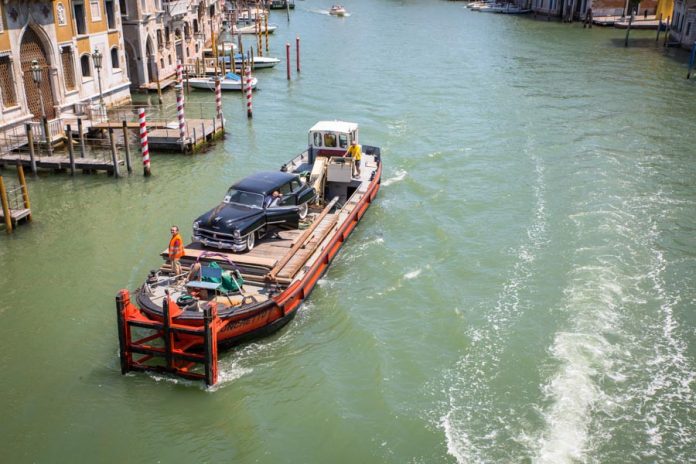
Hybrid of a Chrysler. A Provocation to Fly is Esterio Segura’s first incursion into the universe of book-objects or book-art. How did this idea come about? Why did you select Hybrid of a Chrysler as the starting point for the book?
Gabriela Azcuy (GA): Since its creation, the sculpture has received wide media attention. We could say that its repeated participation in a large number of exhibitions and events generated the need for an increasingly comprehensive dossier that not only gathered the technical aspects of the piece, but also functioned as a sort of logbook of its travels.
When we began to review and compile all the information about Hybrid…, especially that obtained after the passport version was made in 2016, and to recover all the videos and files that the work had generated, we realized that the information was very numerous, however, it was quite scattered. Thus, the project grew as we went along: a volume that we initially conceived with around 60 pages, ended up being a book of 196, bilingual, with documentary images and an original drawing by the artist.
Every project is an opportunity to generate synergies. The process of creating this book was also the opportunity to connect with people who at different times have accompanied the cart in its dissimilar journeys. As part of this, the support of collectors Susie and Mitchell Rice was one of the most precious experiences. Without them, the creation of the passport version in 2016 would not have been possible, and the development of this book project has largely depended on their confidence in the possibilities of reinventing and adapting this piece.
From the editorial point of view, what are the risks and benefits that may exist in the making of a book of this nature?
Esterio Segura (ES): Making a book always represents a risk, a gamble, perhaps even more so in the current context. Since its beginnings, my work has been closely related to the word, I feel a great attachment and interest in the way ideas are woven and how they relate to images. Therefore, I can affirm that this is a path that I will continue to explore, through the organization of other book projects, whose visual guidelines have already been established in this first volume. The realization of this project responds to a very simple need, probably the same one from which my pieces arise, the need to tell a story, to articulate a narrative.
From the point of view of benefits, I believe that the task of establishing a bibliography of the work is fundamental. This type of enterprise always implies promotion, and what is even more important, it brings a multiplication of readings and an amplification of audiences, which is a primordial factor for the work to grow.
GA: In the case of Hybrid of a Chrysler. A Provocation to Fly, the book transcends the theme of sculpture and becomes a pretext for a dialogue on a transversal topic in Esterio’s work: travel. In that sense, one of the benefits of working on this publication has been the possibility of understanding his work as a system, in which motifs such as flight and dreams constantly branch, connect and transform. As a result, and as part of a constant search to translate into editorial language the senses already present in the sculpture, we conceived the volume as an object book.
How do you think Hybrid of a Chrysler. A Provocation to Fly echoes what is happening on the island, particularly in terms of emigration?
ES: The dynamics of emigration are as diverse as the people who have experienced them. In the case of the Cuban context, emigration has played a transcendental role in shaping the nation’s narrative. That division between inside and outside, which seems almost an intrinsic element of the Cuban condition, is a subject I have always been interested in addressing. Above all, because its deep ramifications in national history do not limit its universal nature. It is in relation to this that my idea of making two versions for each of my sculptures related to the universe of the automobile arises, a passport version and a retained version. Thus, the book, and the piece to which it is dedicated, constitutes a platform for dialogue; for me it is the visual representation of a phenomenon that has marked my life and that of those of my generation.
GA: In the book, critic David Horta summarizes: “Symptomatically, in Esterio Segura’s works we always travel, but we don’t know where to, or who we will meet on the way, because we never arrive somewhere. The goal, and the other, are always omitted; they are just a suggestion, a possibility, however grandiloquent it may seem, barely expressed in the very invitation to travel, and open to the experience of an unpremeditated encounter. It is, in short, a truncated narrative, which is completed only in the spectator. The truth is that in a world where the vast majority of people live a sedentary existence, and have never been able to move more than a few miles from home, and where millions desperately seek a way to circumvent the siege of hunger, unemployment, repression or war and migrate to other more hospitable places in search of a better future, the Chrysler is a reminder of those who topple from their homes, and who have never been able to move more than a few miles from home, the Chrysler reminds those who come across it wherever it goes that it comes from an island where people were once children too, believed in the natural desire to be able to travel freely, to fly and explore other lands and meet other people, and that it is never too late to reclaim the validity of that dream. Hybrid of a Chrysler continues, like a stubborn pilgrim, to preach that the homeland, the home, is nothing but the place where one is happy, and that one is happy also on the way to that place”.
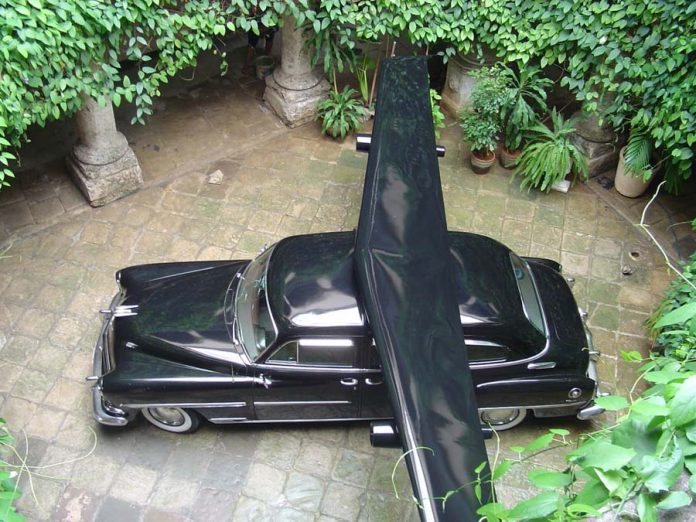
How is the book structured?
GA: The volume was conceived as a book-object with a limited edition of 500 copies, each one signed and numbered by the artist and accompanied by a certificate of authenticity. It consists of a 29 x 30 cm black cloth-covered box with silver stamping for the title on the cover, with a niche and extraction tape for the book, and a support on the inside of the cover to hold the artist’s drawing. In general, it is designed as an object that alludes to the elegance and subtlety of the lines of the sculpture, of the Chrysler limousine of the years 53-54.
In terms of content, it is structured into four sections that take as a common thread Esterio’s lines of research on travel, machinery and hybrids. With each part, the different journeys of the sculpture are followed in detail, in the manner of a road movie or logbook.
The first part begins with a timeline that summarizes the participation or impossibility of participation of the work in different events, and the technical transformations that the piece has undergone over the years. Then, there is an interview with the artist, followed by an analysis of the project No todo lo que vuela se come se come, the series to which the work belongs. Afterwards, reference is made to the emergence of the work, its first exhibition in Havana and the travels of the piece are narrated.
The second part begins with the emergence of the passport version and the trips that Hybrid… has made during the last five years to the Tampa Museum of Art, the Venice Biennial, the Kennedy Center and the Cade Museum.
Almost at the end, the third part is integrated by two critical texts, one is a brief tour of the graphic work of the Hybrid…, and the other is an essay on the drive and the possibility of travel in the work of Esterio Segura, where many other pieces connected to this theme are visually referenced.
The volume closes with a section that includes bibliographical reference data such as the artist’s curriculum vitae, brief statements about The Cuban Arts Group and ESTERIOSTUDIO, photographic credits and acknowledgements. These four parts are generally characterized by a strong emphasis on the visual, which makes the textual journey much more attractive to the reader, and enhances the senses that emerge from the interaction between text and image.
How was the artist-curator relationship between Esterio, author of the work in question, and Gabriela, curator and editorial director of the book? To what extent do you feel that the project grew from that collaboration?
GA: It has been a very equal relationship. From the beginning we trusted each other’s vision and it is based on that mutual trust that the project has been taking shape. As curator I had worked with the sculpture on different occasions, I had also been involved in the production, assembly and disassembly processes, so I had first-hand knowledge of the piece. However, this other phase, the realization of the book, opened up a new aspect for me, which was the research and the whole theoretical and investigative process behind Hybrid… At the same time, the constant collaboration and dialogue between the members of the work team, made up of editor and proofreader Gabriela Rey, English translator and proofreader Noel Smith, critic and researcher David Horta, designers Anabel Medina and Dieiker Bernal, were fundamental elements for the development of the project.
What previous experiences has The Cuban Arts Group, as a non-profit organization that supports Cuban visual arts, had in editing and producing artists’ books?
GA: The Cuban Arts Group’s greatest experience lies in the support and production of art exhibitions and events. This is the first time we have taken on a publishing project of this magnitude in its entirety. Our close relationship with the work in previous exhibitions made this decision seem a logical step in our work agenda. At the same time, it has allowed us to broaden our mission as an institution, insofar as we feel that this first incursion into the publishing world constitutes a way to generate knowledge, connect different agents, and enrich the debate around contemporary Cuban art in the North American context.
Esterio, in the interview included in the book you mention that, for you, “the work [Hybrid of a Chrysler] is nourished by the philosophical idea of movement as a generator of change and evolution”. What do you think then about the work continuing to evolve, now towards the book-catalog format? What do you think this new way of translating the piece can contribute to its original version?
ES: Flight is an image that throughout the history of mankind has generated multiple interpretations. Since my childhood I have always felt that there is an enormous beauty in those in-between spaces, in those indistinguishable gray parts that stand between here and there. Flight has always seemed to me to be the ultimate expression of human aspirations, the most coherent analogy for freedom. That is why I believe that as a concept it is so universal, because it stems from a basic instinct that permeates both personal desires and political aspirations.
Gabriela, what has the exercise of “curating a catalog book” meant to you and what benefits has it brought to your career?
GA: My previous editorial work has been mostly related to art exhibition catalogs or small monographs of artists. In the case of Hybrid… the editorial design is much more complex, because it is a completely bilingual publication, which includes an original drawing by the artist as part of it, which compiles some 120 documentary images and works, and all the research that spans two decades of work. At the same time, it is a deluxe publication, a book-object. I believe that the fundamental benefit lies in enjoying the work process and understanding it as a goal in itself. Being part of the project and working with this team has been an extraordinary experience.
As I understand it, the impact of Hybrid of a Chrysler. A Provocation to Fly is intended to be the same as if it were a work of art by the artist. So what would be the difference, if any, between collecting a piece by Esterio Segura – be it an installation, sculpture, drawing or photograph – and a copy of the book?
GA: Hybrid of a Chrysler. A Provocation to Fly is part of that journey-performance that is the work. A work that with the purpose of the journey has changed its body, its wings, has multiplied into canvases, drawings, engravings, photographs and is now transformed into a book. The intrinsic benefit to the action of acquiring a work or buying a book will ultimately depend on the buyer. From my perspective, each idea brings in its germ the technical needs for its materialization. In this case, a piece of such a mutable nature as the Hybrid…, could not function in any other way than through the multiplicity of formats and the interweaving of dissimilar techniques.
Regarding distribution, where will it be available and from what dates?
After the official launch of the book at the beginning of next year, Hybrid of a Chrysler. A Provocation to Fly will be available for purchase through the networks and websites of The Cuban Arts Group and ESTERIOSTUDIO, as well as at the venues where it will be presented, such as the Tampa Museum of Art in Florida, the Museum of Latin American Art (MoLAA) in Laguna Beach, California, the Sager Reeves Gallery in Missouri, The Keywest Studios in Florida, and the Brownstone Foundation in Paris, among others.



